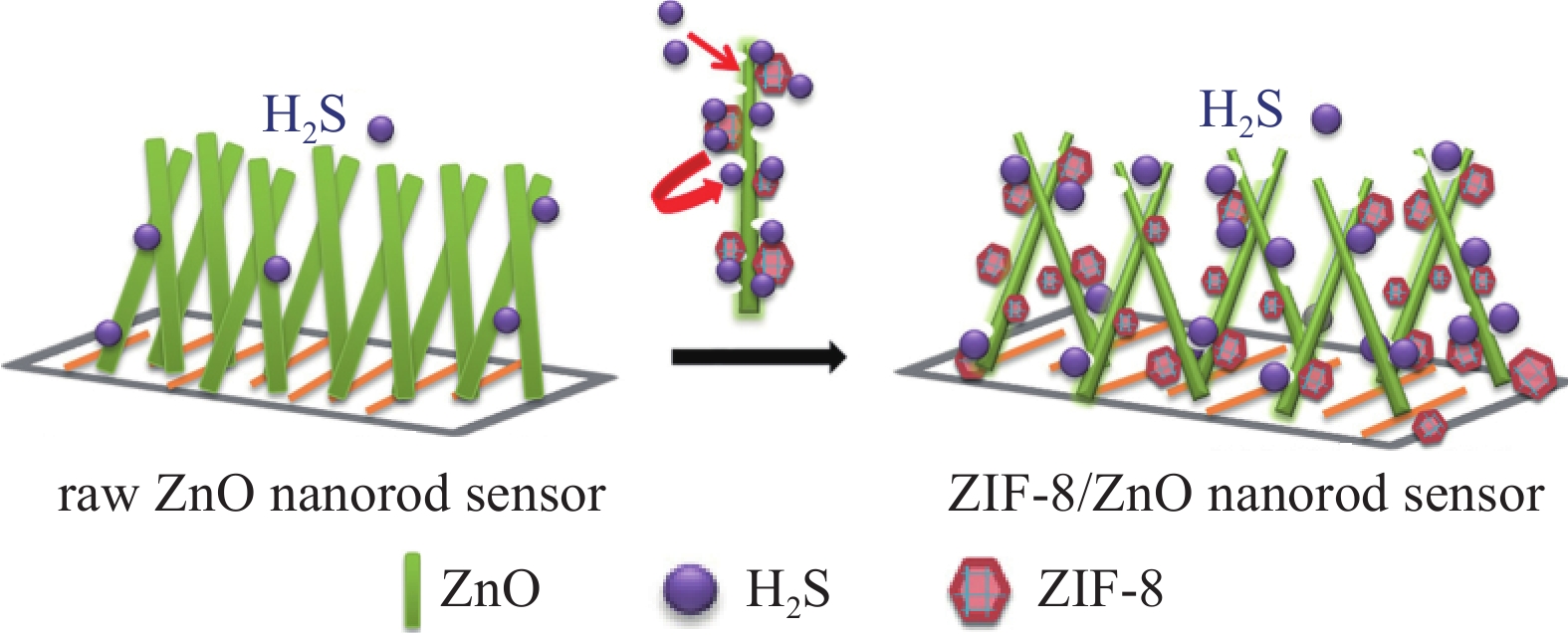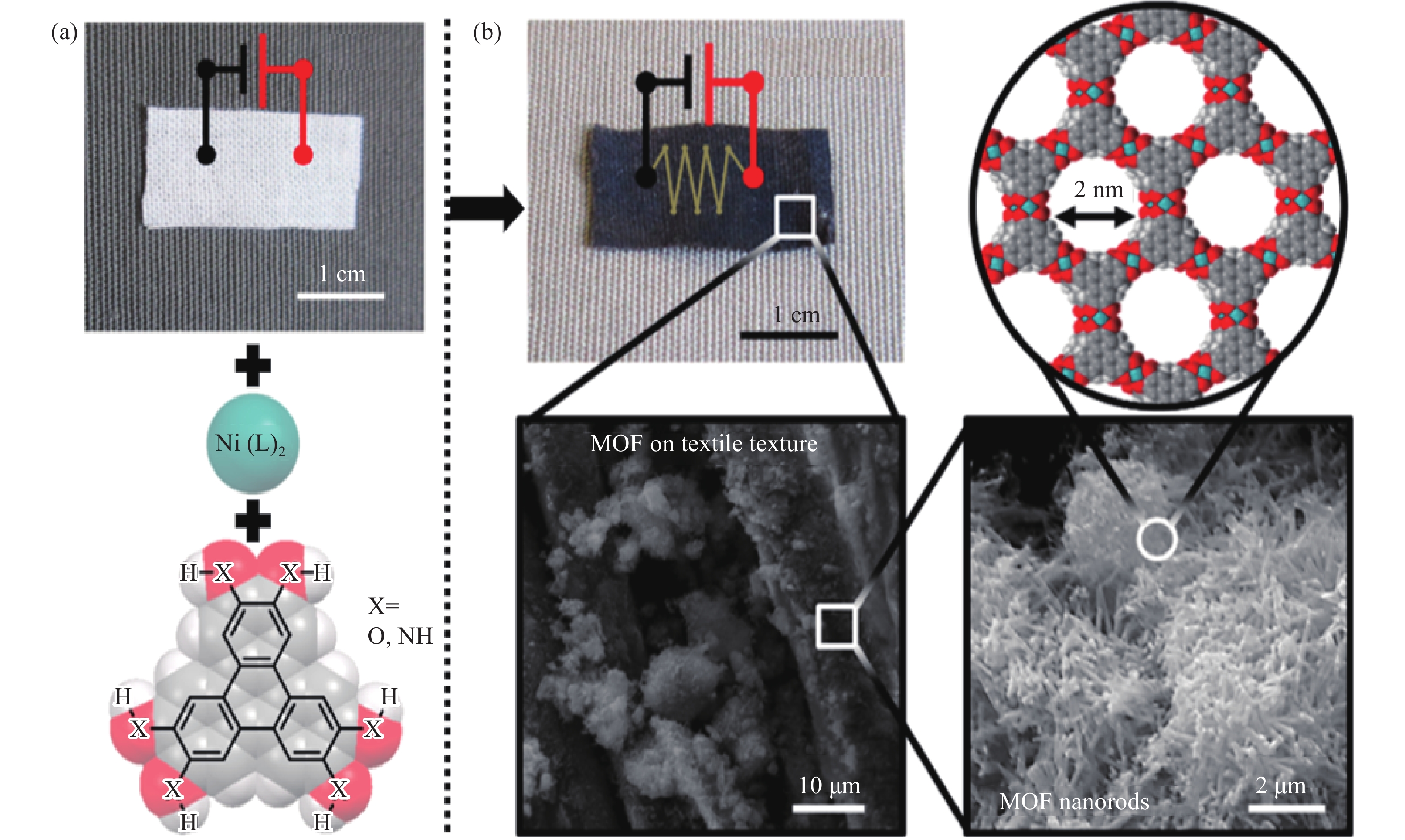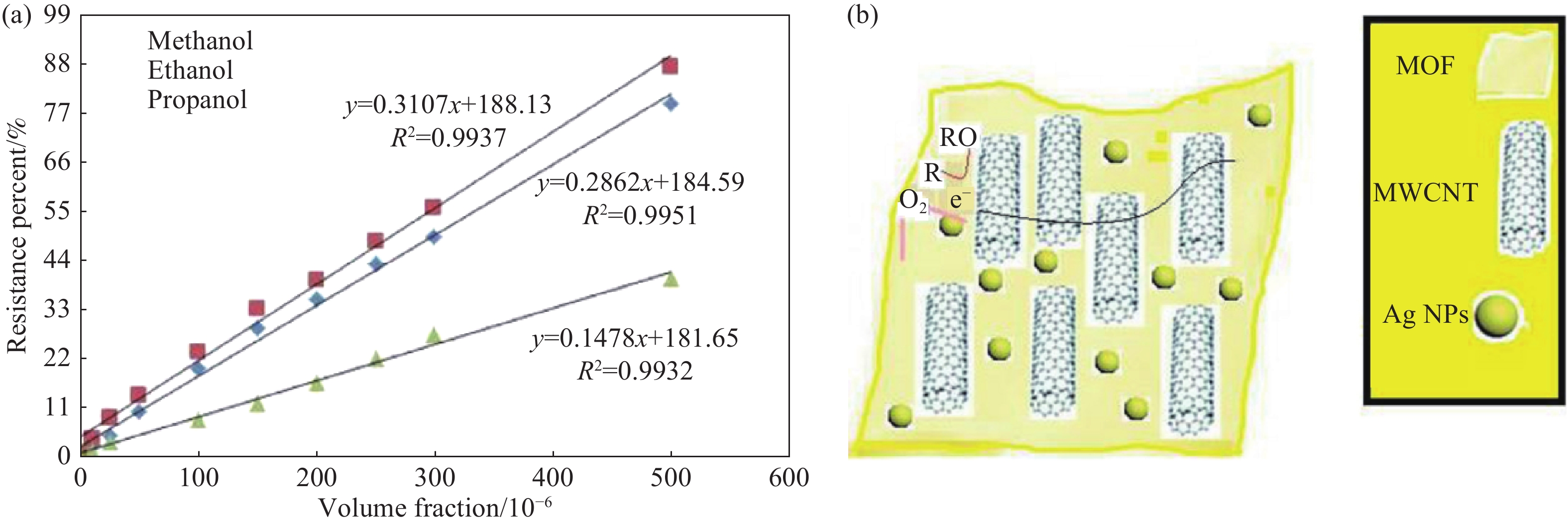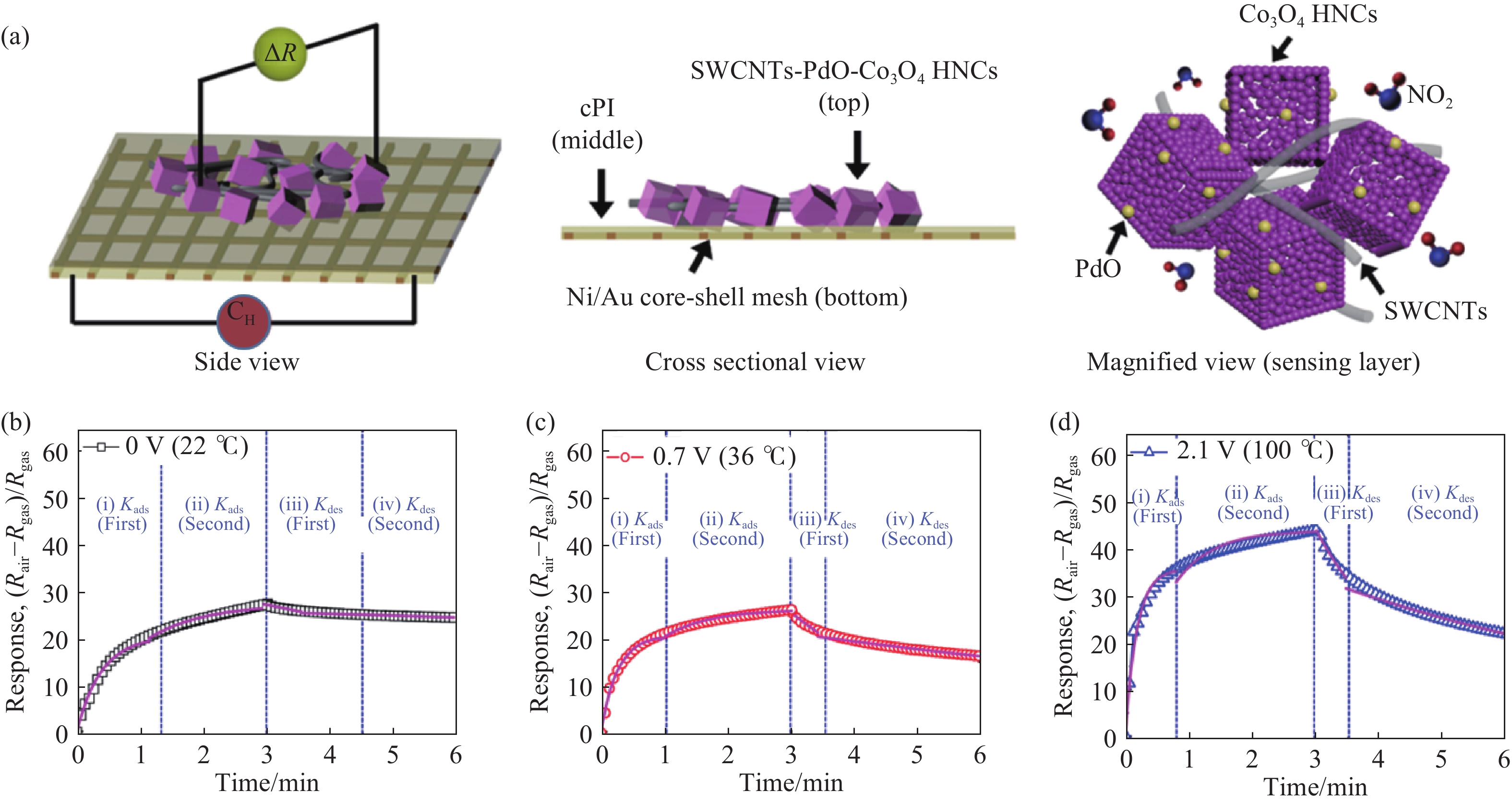-
摘要: 总结了将MOFs材料与金属氧化物、纺织品以及碳基导电纤维材料相结合,并在电阻式气体传感器领域的研究与应用。其中金属氧化物结合MOFs过程中,MOFs主要有两个作用:一是作为分散剂提高金属氧化物的分散性;二是利用MOFs本身具有较大的比表面积和大量的活性位点,来提高材料对于气体分子的吸附量和选择性。当纺织品与MOFs结合的过程中,由于纺织品的导电性相对较差,所以需要结合一些导电性及气体选择性较好的MOFs来作为传感器。碳基导电纤维一般具有较好的机械性能和导电性能,因此将其与MOFs材料复合后用于柔性电阻气体传感器具有一定的优势。Abstract: Metal-organic frameworks (MOFs) are a new class of organic–inorganic hybrid materials that show great potential for gas adsorption and storage. However, the powder form of these materials limits the range of their applications. Integration of MOFs on polymer fiber scaffolds to increase the contact area between these frameworks and target molecules and improve the performance of the resulting material is expected to provide new application prospects in gas adsorption, membrane separation, catalysis, and toxic gas sensing. Electrochemical sensors with good flexibility and high sensitivity and selectivity are needed in environmental detection, disease diagnosis, food safety, and other fields. Flexible resistance sensors are sensitive, low cost, and can be produced on a large scale; thus, these sensors have received extensive attention from researchers. Preparing flexible resistance sensors with high sensitivity, high stability, and good wearing comfort is a current and popular area of research. In this paper, we summarized the research and application of MOFs materials combined with metal oxides, textiles and carbon-based conductive fiber materials in the field of resistance gas sensors. Metal oxides act as a conductive material in resistance sensors bearing a metal oxide-and-MOF design. In this design, MOFs play two roles. First, MOFs can wrap precious metals and form nanoparticles encasing these precious metals when calcined. Here, the precious metal functions as a catalyst while the MOF is used as a dispersant to distribute the metal evenly on the surface of the sensing material. Second, the MOFs are combined with the metal oxide by in situ growth or doping on the metal oxide surface. The MOF surface has a large specific surface area and numerous active sites that can bind with the target gas. Resistance sensing is achieved by changing the electronic distribution within the sensing material. When textiles and MOFs are combined, the resulting resistive sensing materials must have a certain electrical conductivity. However, common MOF materials have poor electrical conductivity. Therefore, developing a conductive MOF material in which 2,3,6,7,10,11-hexahydroxytriphenylene (HHTP) and 2,3,6,7,10,11-hexaaminotriphenylene (HATP) show strong sensing performance for NO, H2S, and H2O is necessary. Carbon nanotube fibers and MOF materials can also be combined to obtain resistive sensor materials. Carbon nanotube materials are characterized by cross contact at the nanoscale and have good mechanical and electrical conductive properties. Thus, they feature certain advantages over other materials when applied to flexible resistive sensors.
-
Keywords:
- metal-organic frameworks /
- fiber /
- flexible /
- gas sensor /
- resistance
-
随着纳米材料、人工智能等领域的技术进步,对于具有高灵敏性和选择性的气体化学传感器的研究与应用也随之增加。目前研究和应用最为广泛的应变传感器是电阻式应变传感器,它可以有效地将应变传感介质的物理形变转变为电阻变化,从而达到应变传感的目的[1-2]。多种材料都可以用作应变传感器中的传感介质,例如金属纳米材料、聚合物材料以及碳纳米材料等[3]。然而在灵敏度、选择性、响应速度以及稳定性上,上述化学传感器仍然面临诸多挑战。例如金属氧化物通常在200~400 ℃下工作,当温度过高或者过低时表现出较差的稳定性。同时金属氧化物作为传感器材料对于气体的选择性也较差,在传感的过程中其他气体的存在会影响测试结果[4]。
金属有机框架(MOFs)由金属离子或者团簇与有机配体通过配位键自组装形成,具有较高的比表面积和超高的孔隙率。在气体储存、分离、催化和化学传感领域已经得到深入研究。尤其在化学传感领域,由于其表面可以和目标气体通过表面反应达到吸附效果,吸附后通过测试MOFs材料的电阻值变化来达到传感的效果。因此MOFs材料应用于电阻式气体传感器具有很大潜力,在本文中总结了MOFs材料与金属氧化物、纺织品以及碳基导电纤维材料相结合用于电阻传感器的研究进展。
1. MOFs/金属氧化物结合用于电阻传感器
金属氧化物作为电阻材料的理想材料例如WO3、ZnO和SnO2,由于其具有低成本、易加工、便携性等优势,目前已在工业上被广泛应用于挥发性有机物的检测[4-7]。Yang等[8]先后利用静电纺丝技术、热压及煅烧技术,将掺杂有Pd的SnO2负载到纳米纤维毡上,制备成对于H2具有较高传感性能的电阻式传感器。其中静电纺丝是生产有机或无机材料纤维最简单、用途最广泛、成本最低的方法之一[9-10]。它提供了生产长连续纤维的能力,典型直径从50 nm到几微米,长度可达几厘米。在静电纺丝过程中,前驱体的水解、缩合和凝胶化等反应参与了纤维的形态和微观结构演变[11]。在煅烧后,有机组分分解,无机前体氧化并结晶形成金属氧化物纳米纤维。
如图1(a)为该研究的技术路线图。对于H2具有较高灵敏性的原因可能是由于:(1)SnO2上修饰的PdO可以促进H2氧化成为H2O,导致其导电性增强;(2)由于掺杂Pd后微晶表面的电子耗尽层增加,导致电阻增加。随后吸附H2后释放电子,电导率大幅度增加。所以通过掺杂Pd可以提高SnO2对于H2的灵敏性。图1(b)比较了负载Pd@SnO2前后对于不同体积分数H2的响应值(I/I0,其中I为传感器在测试气体中的电流值大小,I0为在空气中的电流值大小。),可以看出负载Pd@SnO2之后对于各浓度的H2响应值均明显提升且响应值大小与H2浓度呈线性关系。
![]() 图 1 (a)SnO2传感器的制备流程图,插图为煅烧前后的扫描电子显微镜图像对比;(b)比较未负载和负载30% Pd–SnO2对于H2的响应值;(c) PdO@ZnO−WO2纤维的合成工艺图;(d) 350 ℃时PdO@ZnO−WO2对甲苯的传感性能[8, 12]Figure 1. (a) Schematic diagram illustrating the fabrication process of our SnO2 sensor prototypes, the inset shows images of the materials in the as-spun state and after hot-pressing and calcination obtained by confocal microscopy; (b) electrical responses of unloaded and 30% Pd-loaded SnO2 sensors to H2; (c) schematic illustration of the synthetic process of PdO@ZnO−WO2 nanoparticles; (d) sensitivity of PdO@ZnO−WO2 nanoparticles to toluene at 350 ℃[8, 12]
图 1 (a)SnO2传感器的制备流程图,插图为煅烧前后的扫描电子显微镜图像对比;(b)比较未负载和负载30% Pd–SnO2对于H2的响应值;(c) PdO@ZnO−WO2纤维的合成工艺图;(d) 350 ℃时PdO@ZnO−WO2对甲苯的传感性能[8, 12]Figure 1. (a) Schematic diagram illustrating the fabrication process of our SnO2 sensor prototypes, the inset shows images of the materials in the as-spun state and after hot-pressing and calcination obtained by confocal microscopy; (b) electrical responses of unloaded and 30% Pd-loaded SnO2 sensors to H2; (c) schematic illustration of the synthetic process of PdO@ZnO−WO2 nanoparticles; (d) sensitivity of PdO@ZnO−WO2 nanoparticles to toluene at 350 ℃[8, 12]但是该方法的缺点在于不能将Pd均匀的分散到SnO2中,易发生聚合作用,导致灵敏度下降。随后在此基础上为了使Pd能更均匀的分散在SnO2中,Koo等[12]引入MOFs材料作为中间介质,先将Pd2+在溶剂中通过扩散作用进入到制备好的ZIF-8框架中,然后采用静电纺丝技术和煅烧方法将Pd@ZnO均匀的分散在WO3纤维表面,如图1(c)为该材料的制备工艺图。利用该材料测试其对于甲苯的气敏性,从图1(d)中可以看出对于不同浓度的甲苯,其响应值与甲苯体积分数呈现出较好的线性关系。对于100×10−9体积分数的甲苯其响应值(Rair/Rgas,Rair和Rgas分别表示传感器在空气中和测试气体中的电阻值大小)仍然高达4.37(350 ℃)。在此研究之上Koo等[13]为进一步提高传感器的灵敏度,将纤维基底材质由WO3替换成SnO2,并将其制备为中空结构。可以使更多的目标气体与传感器接触,增加目标气体与传感材料之间的界面反应。在图2(a)中可以看出,首先利用静电纺丝技术制备出Pd@ZIF-8/PVP/Sn纳米纤维,然后通过高温煅烧工艺制备出具有中空结构的Pd@ZnO–SnO2纳米纤维,最后利用其检测目标气体(丙酮)。目标气体既可以与材料的外界面发生反应,也可以通过中空结构进入到材料内部发生反应,大大增加了传感器的响应值。图2(b)为不同材料对于各体积分数丙酮的响应值比较,其中绿线为实心结构的Pd@ZnO–SnO2纳米纤维材料对丙酮的响应值曲线,蓝线为中空结构的Pd@ZnO–SnO2对丙酮的响应值曲线。通过比较,中空结构确实有利于提高响应值。图2(c)、2(d)比较了两种结构的扫描电镜图像,可以看出与之前的研究相比,提高升温速度可以制备出具有中空结构的纤维结构。
![]() 图 2 (a) PdO@ZnO–SnO2纳米纤维合成工艺示意图;(b) 400 ℃下不同材料对0.1×10−6~5×10−6体积分数丙酮的响应值;(c) Pd@ZnO–WO3纳米纤维的扫描电镜图像,插图为表面放大图像;(d) PdO@ZnO-SnO2的扫描电镜图像[13]。Figure 2. (a) Schematic illustration of the synthetic process of PdO@ZnO-SnO2 nanoparticles; (b) Transition of dynamic responses to acetone in the volume fraction range of 0.1×10−6−5.0×10−6 at 400 ℃; (c) SEM images of Pd@ZnO–WO3 nanofibers and magnified image of the material surface; (d) SEM image of PdO@ZnO–SnO2 nanotubes[13]
图 2 (a) PdO@ZnO–SnO2纳米纤维合成工艺示意图;(b) 400 ℃下不同材料对0.1×10−6~5×10−6体积分数丙酮的响应值;(c) Pd@ZnO–WO3纳米纤维的扫描电镜图像,插图为表面放大图像;(d) PdO@ZnO-SnO2的扫描电镜图像[13]。Figure 2. (a) Schematic illustration of the synthetic process of PdO@ZnO-SnO2 nanoparticles; (b) Transition of dynamic responses to acetone in the volume fraction range of 0.1×10−6−5.0×10−6 at 400 ℃; (c) SEM images of Pd@ZnO–WO3 nanofibers and magnified image of the material surface; (d) SEM image of PdO@ZnO–SnO2 nanotubes[13]在上述的研究中MOFs材料仅仅作为一种中间体,其目的是为了提高贵重金属在金属氧化物中的分散程度,并没有利用上MOFs材料具有高活性点位的优势。所以为了追求更快的响应速度和更高的选择性,需要寻找一种金属氧化物与MOFs材料更好的结合方式。Wu等[14]则直接采用原位生长法,利用氧化锌纳米纤维作为Zn源,在ZnO的表面原位生长MOFs(ZIF-8),合成的传感材料用于对H2S的检测(图3)。在该研究中,利用MOFs的高比表面特性,吸附更多的H2S分子附着在ZnO纤维表面,增加其响应值。
在ZnO表面负载MOFs的优点就是可以利用MOFs上更多的开放吸附点位,提高传感器的吸附选择性。相较于单纯的半导体金属氧化物(SMO),其选择性有明显的提高。如图4中(a)和(b)分别为Koo等[12-13]所制备实心和空心的SMO气体传感器对不同气体的响应值,(c)则为SMO负载ZIF-8对于不同气体的响应值比较。在(a)中对于甲苯的响应值大约是第二响应值丙酮的3.2倍,(b)中第一响应值(C3H6O)约是第二响应值(H2S)的2.2倍,而在(c)中第一响应值(H2S)大约是第二响应值(H2)的7倍左右,要明显高于(a)和(b)。说明在SMO上负载MOFs确实可以提高传感材料的选择性。但是该方法的缺点在于MOFs材料的热稳定性和化学稳定性普遍较差[15],导致制备出的传感材料同样具备上述缺点。所以进一步提高MOFs材料的稳定性,将会是SMO/MOFs材料应用于传感器领域的一个研究趋势。
Yao等[4]则提出将纤维结构并且具有催化活性的金属氧化物与高选择性的MOFs进行结合提高电阻式传感器的性能。首先将金属氧化物(ZnO)作为气敏反应和随后的电信号传输核心材料,然后利用溶液法在ZnO纳米纤维的表面合成一层ZIF–CoZn,形成一种同心结构。这种同心结构可以选择性的吸附目标物种,并且MOFs材料可以阻止气体与金属氧化物接触,极大的提高了传感器的性能。由于ZIF–CoZn材料具有较高的疏水性,所以该传感器可以用于高湿度下对于超低浓度的丙酮进行检测,对于临床应用及环境检测具有重要的应用价值。图5(a)为其制备过程。
![]() 图 5 (a) ZnO@ZIF–CoZn气体传感器的制备原理图;(b) ZnO and ZnO@ ZIF–CoZn的平面图和截面图;(c) ZnO@5 nm ZIF–CoZn对不同体积分数丙酮的响应值,并且在10×10−6体积分数下测试对于不同湿度的响应值[4]Figure 5. (a) Schematic illustration of the preparation of ZnO@ZIF–CoZn gas sensors; (b) plan and cross-sectional views of ZnO and ZnO@ ZIF–CoZn nanowire arrays: (1,3) HRTEM image of pure ZnO and SAED patterns of a single ZnO nanowire (in inset), (2,4) ZnO@15 nm ZIF–CoZn;(c) response–recovery curves of ZnO@5 nm ZIF–CoZn toward acetone of different volume fraction in dry air and 10×10−6 acetone at different relative humidities[4]
图 5 (a) ZnO@ZIF–CoZn气体传感器的制备原理图;(b) ZnO and ZnO@ ZIF–CoZn的平面图和截面图;(c) ZnO@5 nm ZIF–CoZn对不同体积分数丙酮的响应值,并且在10×10−6体积分数下测试对于不同湿度的响应值[4]Figure 5. (a) Schematic illustration of the preparation of ZnO@ZIF–CoZn gas sensors; (b) plan and cross-sectional views of ZnO and ZnO@ ZIF–CoZn nanowire arrays: (1,3) HRTEM image of pure ZnO and SAED patterns of a single ZnO nanowire (in inset), (2,4) ZnO@15 nm ZIF–CoZn;(c) response–recovery curves of ZnO@5 nm ZIF–CoZn toward acetone of different volume fraction in dry air and 10×10−6 acetone at different relative humidities[4]从图5(c)中可以看出,丙酮体积分数在10.0×10−6条件下,在10%~90%湿度范围内,传感器的响应值几乎没发生变化。反而在有水汽存在的情况下要比无水汽时响应值要大。说明该材料不仅具有防水性能,而且水的存在有利于提高传感器的响应值。该材料制备的传感器对于丙酮气体的最低检测值为0.25×10−6,并且在(0.25~100)×10−6之间具有良好的响应恢复特性。
2. MOFs/纺织品结合用于电阻传感器
目前将柔性电子产品与纺织品结合制备成可穿戴电子产品用于健康监控[16]、环境污染防治[17]等领域成为热门方向及未来发展趋势。目前将MOFs材料与织物结合的方法有热溶剂法[18-19]、喷涂法[20]、后合成附着法[21]、电化学沉积法[22]、原子层沉积法[1]和直接沉积法[23]等。
Zhang等[24]利用喷墨打印法,通过打印机装置将MOF-199的前驱体均匀的喷涂在纸张及纺织品上。随后通过80 ℃下加热后在纸张及纺织品的表面形成均匀稳定的MOFs层,并将制备出的材料作为氨气传感器。如图6(a)为该研究的基本路线,首先将Cu(NO3)2·3H2O和1,3,5-benzenetricarboxylic acid溶解在二甲基亚砜中形成前驱体溶液,随后再将前驱体溶液分散到乙醇和乙二醇混合物中。将制备好的溶液装入到打印机的墨盒中,最终通过打印机印刷技术将MOFs按照自己设计的图形印刷在纺织品或者纸类上。
![]() 图 6 (a)通过喷墨印刷技术,将HKUST-1合成在柔性基材上;(b) HKUST-1暴露在不同气体前后的对比照片;(c) HKUST-1的扫描电镜图像;(d) HKUST-1对于NH3的传感响应曲线[24]。Figure 6. (a) Inkjet printing of SURMOFs onto flexible substrates using a HKUST-1 precursor solution as “ink”; (b) photographs of a dot of HKUST-1 printed onto textiles before and after exposure to different gases; (c) SEM images of a HKUST-1 printed paper fiber; (d) partial reversible adsorption/desorption of NH3 on HKUST-1 film[24]
图 6 (a)通过喷墨印刷技术,将HKUST-1合成在柔性基材上;(b) HKUST-1暴露在不同气体前后的对比照片;(c) HKUST-1的扫描电镜图像;(d) HKUST-1对于NH3的传感响应曲线[24]。Figure 6. (a) Inkjet printing of SURMOFs onto flexible substrates using a HKUST-1 precursor solution as “ink”; (b) photographs of a dot of HKUST-1 printed onto textiles before and after exposure to different gases; (c) SEM images of a HKUST-1 printed paper fiber; (d) partial reversible adsorption/desorption of NH3 on HKUST-1 film[24]在作为传感器方面,从图6(b)中可以看出,该传感材料对于不同的气体吸附后显示出不同的颜色。此现象不仅表明了捕获过程,而且还说明了将喷墨打印技术作为制备一种可识别不同气体并且廉价和实用的气体传感器的可能性。通过图6(c)可以看出通过该合成方法,在纸质基底上生长出均匀且稳定的MOF-199晶体。由于在制备过程中加入了乙二醇,使得生成的MOFs表面存在大量的孔状结构,极大增加了材料的比表面积,有利于后续提高气体传感器性能。图6(d)则利用该传感材料测试其对于NH3气体的响应值。该研究的创新之处就是找到了一种理想的合成方法将MOFs与纺织品很好的结合起来。
虽然上述方法制备出的传感器可以用于气体检测,但是其传感机理是通过传感材料吸附目标分子前后重量的变化来检测目标气体。该传感过程属于物理方式进行传感,其缺点就是稳定性和实际应用性较差。所以为了进一步提高传感器的检测性能,可将传感材料制备成电阻式传感器。利用传感材料与目标气体接触后本身的电阻值发生变化,进一步测得目标气体浓度。在此研究方向上则需要本身的传感材料具有一定的导电性,所以MOFs与织物结合作为传感材料就需要两者中至少有一者要具有导电性。将织物制备成具有导电性在工艺上和实际应用上很难以实现,所以可以把MOFs材料制备为导电材料。
Smith与Mirica[25]研究了一种简单快速的方法,直接通过液相自组装方式将导电金属有机框架合成到织物上。制备出的电子纺织品在导电性、孔隙率、柔韧性和稳定性上都表现出较高的性能。在用于传感器方面上,该传感材料对于低浓度的目标气体(NO、H2S、H2O)具有较强的选择性,并且在高湿度下仍然能保持较好的传感性能。如图7(a)为传感器的制备过程示意图,可以看出在制备之前,纺织品的电阻趋于无穷大,可认为是绝缘体。当通过添加金属盐和有机配体在其表面合成MOFs之后,制备出的材料导电性明显增强,电阻降低到MΩ水平。如图7(b)为材料在不同放大倍数下的形貌特征。
该研究的亮点如下:(1)该研究是首次将导电MOFs材料与纺织品进行结合,并用于传感材料;(2)具有介孔结构的织物与具有微孔结构的导电MOFs结合后,其整体孔隙率增大;(3)MOFs基化学电阻器件中第一次同时具备检测、捕捉、预浓缩和过滤功能;(4)在高湿度下,该传感材料仍然可以保持其功能完整性、导电性和气敏性;(5)具有较好的柔性,可水洗,并且受热稳定;(6)该传感器具有较好的传感性能,对于NO和H2S其最低检测值分别为0.16×10−6和0.23×10−6。
Hmadeh等[26]和Sheberla等[27]则分别研究了Ni3HHTP2和Ni3HITP2两种导电MOFs与棉织品或者聚合物结合的方法,并对其导电性能进行了具体研究。
3. MOFs/碳纳米管纤维结合用于电阻传感器
碳纳米材料因其纳米尺度的交叉接触、机械特性和导电性能优异等优点,非常适合用作应变传感器中传感介质的材料[28]。
Ghanbarian等[29]采用声化学方法合成了双金属(Cr、Fe)型金属有机框架MIL-53并和Ag/CNT组成三元纳米复合材料,用于制备电阻式气体传感器。在环境条件下(10%相对湿度,25 ℃)测试对于甲醇、乙醇和异丙醇的响应值。通过图8(a)可以看出对于3种气体,响应值与体积分数之间均有较好的线性关系,其R2值均大于0.99。作者在相同的体积分数下均进行4次重复实验(一次重复实验包括充入一定浓度的目标气体至响应值稳定,然后通入空气至响应值稳定在最低值),在各体积分数下4次重复实验的结果都比较稳定,说明该传感材料具有较强的稳定性。对比3种气体,对于甲醇的传感特性最好,最低检出限可以达到30.5×10−6。
![]() 图 8 (a)校准曲线在体积分数范围为(10~500)×10−6时用于分析物(甲醇,乙醇和异丙醇)的传感器;(b)MIL-53(Cr-Fe)/Ag/CNT三元纳米复合材料的传感机理[29]Figure 8. (a) Calibration curves of the sensors for different analytes (methanol, ethanol, and iso-propanol) in the volume fraction range of (10–500)×10−6; (b) sensing mechanism of the MIL-53(Cr-Fe)/Ag/CNT ternary nanocomposite[29]
图 8 (a)校准曲线在体积分数范围为(10~500)×10−6时用于分析物(甲醇,乙醇和异丙醇)的传感器;(b)MIL-53(Cr-Fe)/Ag/CNT三元纳米复合材料的传感机理[29]Figure 8. (a) Calibration curves of the sensors for different analytes (methanol, ethanol, and iso-propanol) in the volume fraction range of (10–500)×10−6; (b) sensing mechanism of the MIL-53(Cr-Fe)/Ag/CNT ternary nanocomposite[29]图8(b)为此类传感材料的传感机理示意图,该传感器的传感机理分为两部分,(1)将目标气体与传感材料接触后,由于吸附目标分子,导致碳纳米管之间的距离增大,导电性变差,电阻值增加。(2)大气中的氧气与银纳米粒子发生反应,将吸收的电子扩散到MOFs纳米粒子和碳纳米管中,从而提高导电性。一旦传感材料暴露在具有极性的还原性气体中时(如甲醇、乙醇和丙酮),这些气体就会从传感材料中捕获电子。因此电导率会明显增加,导致电阻值变大。而当传感材料暴露在非极性气体中(如甲苯)时,吸附氧中的电子重新回到传感材料中,导电率增强,电阻值随之下降。
Choi等[30]则研究了一种可加热的NO2传感器,该传感器包括两个部分,第一部分为传感层,将包裹有PdO的Co3O4中空纳米粒子修饰在具有导电性的单壁碳纳米管上,作为电阻式传感材料。第二部分为Ni(core)/Au(shell) mesh结构,即在镍网表面附着一层40 nm厚的金层,并镶嵌在无色聚酰亚胺中基底上,如图9(a)为传感器传感示意图。通过对其施加不同电压CH,使加热层控制在不同的温度。该研究表明在不同的温度下,该传感材料对于NO2的电阻响应值(ΔR)大小不同,如图9(b)、(c)、(d),分别在0 V(22 ℃)、0.7 V(36 ℃)和2.1 V(100 ℃)下对于NO2的响应过程(其中Kdes为解吸速率常数,Kads为吸附速率常数)。对比3张图可以看出,在100 ℃下其响应值达到最大,说明温度的提高有利于提高传感器的灵敏性。此研究可应用于在低温情况下检测NO2并且在可穿戴领域也具有较好的应用前景。
![]() 图 9 (a)传感器示意图;0 V (22 ℃)(b),0.7 V (36 ℃) (c)和2.1 V (100 ℃) (d)下传感器的响应和恢复动力学曲线[30]Figure 9. (a) Schematic illustrations of the overall sensing platform; response and recovery kinetics of SWCNT-loaded PdO–Co3O4 HNCs on cPI film toward the Ni/Au-cPI heater at 0 V (22 °C) (b), 0.7 V (36 °C) (c), and 2.1 V (100 °C) (d)[30]
图 9 (a)传感器示意图;0 V (22 ℃)(b),0.7 V (36 ℃) (c)和2.1 V (100 ℃) (d)下传感器的响应和恢复动力学曲线[30]Figure 9. (a) Schematic illustrations of the overall sensing platform; response and recovery kinetics of SWCNT-loaded PdO–Co3O4 HNCs on cPI film toward the Ni/Au-cPI heater at 0 V (22 °C) (b), 0.7 V (36 °C) (c), and 2.1 V (100 °C) (d)[30]在此研究中,利用单壁碳纳米管作为导电基材,PdO–Co3O4纳米粒子的制备方法如下:首先通过溶液渗透的方式将制备好的ZIF-67(Co3O4源)浸泡在含有Pd离子的溶液中,使Pd离子渗入到ZIF-67的内部。然后通过煅烧的方式得到包裹有PdO的Co3O4纳米粒子,最终将PdO–Co3O4粒子修饰到碳纳米管上制备为传感材料。在该过程中MOFs起到两个作用,一方面利用其高比表面积的特性可以使PdO均匀的分散在传感材料的表面,另一方面ZIF-67煅烧后可以形成Co3O4作为传感材料。该研究的亮点有两点:(1)利用Ni/Au金属网作为柔性加热装置,可以使该传感器在低温下仍具有较高的传感性能。(2)将MOFs作为前驱体物质,利用其高比表面积的特点将PdO均匀的分散在传感材料表面,提高传感性能。
Rui等[28]则将ZIF-67-Co和MIL-88-Fe与多壁碳纳米管进行结合制备成柔性电阻式传感器用于检测NO2气体。该传感材料的优点就是在无需外部加热的条件下可以对NO2进行检测,其最低检测体积分数可以达到0.1×10−6。并且当传感材料在不同的弯曲角度下,仍可以保持较好的传感稳定性,极大的提高了其在可穿戴领域的应用范围。
4. 总结
总结了3种MOFs与纤维结合的方式并用于电阻式气体传感器,分别为金属氧化物与MOFs材料、纺织品与MOFs材料和碳纳米管纤维与MOFs材料。在金属氧化物与MOFs结合用于电阻式传感器材料部分,金属氧化物通常作为导电材料,在此部分MOFs的作用分为两个方向,第一可以与贵重金属结合,将贵重金属包裹在MOFs的内部,通过煅烧后形成包裹有贵重金属的纳米粒子,将贵重金属作为催化剂均匀的分散在传感材料表面,在这里MOFs利用其高比表面积的特性,起到分散剂的作用。第二通过在金属氧化物表面原位生长或者在与金属氧化物进行掺杂,将金属氧化物与MOFs结合。利用MOFs表面具有较高的比表面积,同时MOFs表面具有很多的开放位点可以和目标气体进行结合,从而改变传感材料内部的电子分布状态,达到电阻传感的效果。相比于两种MOFs的结合方式,第一种方式由于存在贵重金属催化剂,所以可以增加传感材料的响应值。第二种方式的优点在于利用MOFs表面具有更多开放位点,所以对目标气体具有更高的选择性。在纺织品与MOFs结合部分,由于电阻传感材料本身需要具有一定的导电性,而一般常见的MOFs材料导电性均较差,并且提高纺织品的导电性在工业上并不实用。所以需要寻找一种导电的MOFs材料,其中HHTP和HATP对于NO、H2S和H2O均表现出较强的响应值。将传感器与纺织品结合用于智能穿戴领域,在未来将会有巨大的应用价值。第三部分是将碳纳米管纤维与MOFs材料进行结合,碳纳米管材料的特点就是在纳米尺度可以交叉接触,具有较好的机械特性和导电性,所以用于柔性电阻传感材料具有一定的优势。
-
图 1 (a)SnO2传感器的制备流程图,插图为煅烧前后的扫描电子显微镜图像对比;(b)比较未负载和负载30% Pd–SnO2对于H2的响应值;(c) PdO@ZnO−WO2纤维的合成工艺图;(d) 350 ℃时PdO@ZnO−WO2对甲苯的传感性能[8, 12]
Figure 1. (a) Schematic diagram illustrating the fabrication process of our SnO2 sensor prototypes, the inset shows images of the materials in the as-spun state and after hot-pressing and calcination obtained by confocal microscopy; (b) electrical responses of unloaded and 30% Pd-loaded SnO2 sensors to H2; (c) schematic illustration of the synthetic process of PdO@ZnO−WO2 nanoparticles; (d) sensitivity of PdO@ZnO−WO2 nanoparticles to toluene at 350 ℃[8, 12]
图 2 (a) PdO@ZnO–SnO2纳米纤维合成工艺示意图;(b) 400 ℃下不同材料对0.1×10−6~5×10−6体积分数丙酮的响应值;(c) Pd@ZnO–WO3纳米纤维的扫描电镜图像,插图为表面放大图像;(d) PdO@ZnO-SnO2的扫描电镜图像[13]。
Figure 2. (a) Schematic illustration of the synthetic process of PdO@ZnO-SnO2 nanoparticles; (b) Transition of dynamic responses to acetone in the volume fraction range of 0.1×10−6−5.0×10−6 at 400 ℃; (c) SEM images of Pd@ZnO–WO3 nanofibers and magnified image of the material surface; (d) SEM image of PdO@ZnO–SnO2 nanotubes[13]
图 4 (a) Pd@ZnO–WO3纳米纤维在350 ℃下对于不同气体的选择性;(b) PdO@ZnO–SnO2纳米纤维在400 ℃下对于不同气体的选择性;(c) ZnO和ZIF-8/ZnO对于不同气体的选择性[12-14]
Figure 4. (a) Selective detection characteristics of Pd@ZnO-WO3 nanofibers toward toluene in the presence of multiple interfering analytes at 350 °C; (b) selective sensing characteristics of PdO@ZnO–SnO2 nanoparticles at 400 ℃; (c) selective of ZnO and ZIF-8/ZnO for different gases[12-14]
图 5 (a) ZnO@ZIF–CoZn气体传感器的制备原理图;(b) ZnO and ZnO@ ZIF–CoZn的平面图和截面图;(c) ZnO@5 nm ZIF–CoZn对不同体积分数丙酮的响应值,并且在10×10−6体积分数下测试对于不同湿度的响应值[4]
Figure 5. (a) Schematic illustration of the preparation of ZnO@ZIF–CoZn gas sensors; (b) plan and cross-sectional views of ZnO and ZnO@ ZIF–CoZn nanowire arrays: (1,3) HRTEM image of pure ZnO and SAED patterns of a single ZnO nanowire (in inset), (2,4) ZnO@15 nm ZIF–CoZn;(c) response–recovery curves of ZnO@5 nm ZIF–CoZn toward acetone of different volume fraction in dry air and 10×10−6 acetone at different relative humidities[4]
图 6 (a)通过喷墨印刷技术,将HKUST-1合成在柔性基材上;(b) HKUST-1暴露在不同气体前后的对比照片;(c) HKUST-1的扫描电镜图像;(d) HKUST-1对于NH3的传感响应曲线[24]。
Figure 6. (a) Inkjet printing of SURMOFs onto flexible substrates using a HKUST-1 precursor solution as “ink”; (b) photographs of a dot of HKUST-1 printed onto textiles before and after exposure to different gases; (c) SEM images of a HKUST-1 printed paper fiber; (d) partial reversible adsorption/desorption of NH3 on HKUST-1 film[24]
图 8 (a)校准曲线在体积分数范围为(10~500)×10−6时用于分析物(甲醇,乙醇和异丙醇)的传感器;(b)MIL-53(Cr-Fe)/Ag/CNT三元纳米复合材料的传感机理[29]
Figure 8. (a) Calibration curves of the sensors for different analytes (methanol, ethanol, and iso-propanol) in the volume fraction range of (10–500)×10−6; (b) sensing mechanism of the MIL-53(Cr-Fe)/Ag/CNT ternary nanocomposite[29]
图 9 (a)传感器示意图;0 V (22 ℃)(b),0.7 V (36 ℃) (c)和2.1 V (100 ℃) (d)下传感器的响应和恢复动力学曲线[30]
Figure 9. (a) Schematic illustrations of the overall sensing platform; response and recovery kinetics of SWCNT-loaded PdO–Co3O4 HNCs on cPI film toward the Ni/Au-cPI heater at 0 V (22 °C) (b), 0.7 V (36 °C) (c), and 2.1 V (100 °C) (d)[30]
-
[1] Zhao J J, Losego M D, Lemaire P C, et al. Highly adsorptive, MOF-functionalized nonwoven fiber mats for hazardous gas capture enabled by atomic layer deposition. <italic>Adv Mater Interfaces</italic>, 2014, 1(4): 1400040 doi: 10.1002/admi.201400040
[2] Koo W T, Jang J S, Kim I D. Metal-organic frameworks for chemiresistive sensors. <italic>Chem</italic>, 2019, 5(8): 1938 doi: 10.1016/j.chempr.2019.04.013
[3] Alrammouz R, Podlecki J, Abboud P, et al. A review on flexible gas sensors: from materials to devices. <italic>Sensors Actuat A-Phys</italic>, 2018, 284: 209 doi: 10.1016/j.sna.2018.10.036
[4] Yao M S, Tang W X, Wang G E, et al. MOF thin film-coated metal oxide nanowire array: significantly improved chemiresistor sensor performance. <italic>Adv Mater</italic>, 2016, 28(26): 5229 doi: 10.1002/adma.201506457
[5] Zhan S, Li D M, Liang S F, et al. A novel flexible room temperature ethanol gas sensor based on SnO<sub>2</sub> doped poly-diallyldimethylammonium chloride. <italic>Sensors</italic>, 2013, 13(4): 4378 doi: 10.3390/s130404378
[6] Tonezzer M, Lacerda R G. Zinc oxide nanowires on carbon microfiber as flexible gas sensor. <italic>Physica E</italic>, 2012, 44(6): 1098 doi: 10.1016/j.physe.2010.11.029
[7] Lin J, Liang F, Lu X Y, et al. Modeling and designing fault-tolerance mechanisms for MPI-based mapreduce data computing framework // 2015 IEEE First International Conference on Big Data Computing Service and Applications. Redwood City, 2015: 176
[8] Yang D J, Kamienchick I, Youn D Y, et al. Ultrasensitive and highly selective gas sensors based on electrospun SnO<sub>2</sub> nanofibers modified by Pd loading. <italic>Adv Funct Mater</italic>, 2010, 20(24): 4258 doi: 10.1002/adfm.201001251
[9] Zhang X L, Fan W, Li H, et al. Extending cycling life of lithium–oxygen batteries based on novel catalytic nanofiber membrane and controllable screen-printed method. <italic>J Mater Chem A</italic>, 2018, 6(43): 21458 doi: 10.1039/C8TA07884J
[10] Zhang X L, Fan W, Zhao S Y, et al. An efficient, bifunctional catalyst for lithium–oxygen batteries obtained through tuning the exterior Co<sup>2+</sup>/Co<sup>3+</sup> ratio of CoO<sub><italic>x</italic></sub> on N-doped carbon nanofibers. <italic>Catal Sci Technol</italic>, 2019, 9(8): 1998 doi: 10.1039/C9CY00477G
[11] Yang W, Li N W, Zhao S Y, et al. A breathable and screen-printed pressure sensor based on nanofiber membranes for electronic skins. <italic>Adv Mater Technol</italic>, 2018, 3(2): 1700241 doi: 10.1002/admt.201700241
[12] Koo W T, Choi S J, Kim S J, et al. Heterogeneous sensitization of metal-organic framework driven metal@metal oxide complex catalysts on oxide nanofiber scaffold toward superior gas sensors. <italic>J Am Chem Soc</italic>, 2016, 138(40): 13431 doi: 10.1021/jacs.6b09167
[13] Koo W T, Jang J S, Choi S J, et al. Metal-organic framework templated catalysts: dual sensitization of PdO–ZnO composite on hollow SnO<sub>2</sub> nanotubes for selective acetone sensors. <italic>ACS Appl Mater Interfaces</italic>, 2017, 9(21): 18069 doi: 10.1021/acsami.7b04657
[14] Wu X N, Xiong S S, Gong Y, et al. MOF–SMO hybrids as a H<sub>2</sub>S sensor with superior sensitivity and selectivity. <italic>Sensors Actuat B</italic>:<italic>Chem</italic>, 2019, 292: 32 doi: 10.1016/j.snb.2019.04.076
[15] Talin A A, Centrone A, Ford A C, et al. Tunable electrical conductivity in metal-organic framework thin film devices. <italic>Science</italic>, 2014, 343(6166): 66 doi: 10.1126/science.1246738
[16] Shi J D, Liu S, Zhang L S, et al. Smart textile-integrated microelectronic systems for wearable applications. <italic>Adv Mater</italic>, 2020, 32(5): 1901958 doi: 10.1002/adma.201901958
[17] Zhang Y Y, Yuan S, Feng X, et al. Preparation of nanofibrous metal-organic framework filters for efficient air pollution control. <italic>J Am Chem Soc</italic>, 2016, 138(18): 5785 doi: 10.1021/jacs.6b02553
[18] Bradshaw D, Garai A, Huo J. Metal-organic framework growth at functional interfaces: thin films and composites for diverse applications. <italic>Chem Soc Rev</italic>, 2012, 41(6): 2344 doi: 10.1039/C1CS15276A
[19] Denny Jr M S, Moreton J C, Benz L, et al. Metal–organic frameworks for membrane-based separations. <italic>Nat Rev Mater</italic>, 2016, 1(12): 16078 doi: 10.1038/natrevmats.2016.78
[20] López-Maya E, Montoro C, Rodríguez-Albelo L M, et al. Textile/metal-organic-framework composites as self-detoxifying filters for chemical-warfare agents. <italic>Angew Chem Int Ed</italic>, 2015, 54(23): 6790 doi: 10.1002/anie.201502094
[21] Liu J X, Wöll C. Surface-supported metal–organic framework thin films: fabrication methods, applications, and challenges. <italic>Chem Soc Rev</italic>, 2017, 46(19): 5730 doi: 10.1039/C7CS00315C
[22] Li M Y, Dincă M. Reductive electrosynthesis of crystalline metal-organic frameworks. <italic>J Am Chem Soc</italic>, 2011, 133(33): 12926 doi: 10.1021/ja2041546
[23] Ozer R R, Hinestroza J P. One-step growth of isoreticular luminescent metal–organic frameworks on cotton fibers. <italic>RSC Adv</italic>, 2015, 5(25): 19400 doi: 10.1039/C5RA90014J
[24] Zhang J L, Ar D, Yu X J, et al. Patterned deposition of metal-organic frameworks onto plastic, paper, and textile substrates by inkjet printing of a precursor solution. <italic>Adv Mater</italic>, 2013, 25(33): 4631 doi: 10.1002/adma.201301626
[25] Smith M K, Mirica K A. Self-organized frameworks on textiles (SOFT): conductive fabrics for simultaneous sensing, capture, and filtration of gases. <italic>J Am Chem Soc</italic>, 2017, 139(46): 16759 doi: 10.1021/jacs.7b08840
[26] Hmadeh M, Lu Z, Liu Z, et al. New porous crystals of extended metal-catecholates. <italic>Chem Mater</italic>, 2012, 24(18): 3511 doi: 10.1021/cm301194a
[27] Sheberla D, Sun L, Blood-Forsythe M A, et al. High electrical conductivity in Ni-3(2, 3, 6, 7, 10, 11-hexaiminotriphenyl-ene)(2), a semiconducting metal-organic graphene analogue. <italic>J Am Chem Soc</italic>, 2014, 136(25): 8859 doi: 10.1021/ja502765n
[28] Rui K, Wang X S, Du M, et al. Dual-function metal–organic framework-based wearable fibers for gas probing and energy storage. <italic>ACS Appl Mater Interfaces</italic>, 2018, 10(3): 2837 doi: 10.1021/acsami.7b16761
[29] Ghanbarian M, Zeinali S, Mostafavi A. A novel MIL-53(Cr-Fe)/Ag/CNT nanocomposite based resistive sensor for sensing of volatile organic compounds. <italic>Sensors Actuat B-Chem</italic>, 2018, 267: 381 doi: 10.1016/j.snb.2018.02.138
[30] Choi S J, Choi H J, Koo W T, et al. Metal-organic framework-templated PdO-Co<sub>3</sub>O<sub>4</sub> nanocubes functionalized by SWCNTs: improved NO<sub>2</sub> reaction kinetics on flexible heating film. <italic>ACS Appl Mater Interfaces</italic>, 2017, 9(46): 40593 doi: 10.1021/acsami.7b11317
-
期刊类型引用(4)
1. 何浩波,李海旭,姜天男,徐良,汪龙,王嘉宁,彭培益,高紫赤,覃宇鑫,刘晓光,薛文东. Fe_3O_4与ZIF-9复合催化剂的制备及其快速降解亚甲基蓝的研究. 工程科学学报. 2024(02): 268-278 .  本站查看
本站查看
2. 秦聪,王兵,王应德. 金属有机框架及其衍生的金属氧化物在电阻式气体传感器中的应用. 无机化学学报. 2022(03): 377-398 .  百度学术
百度学术
3. 牛犇,张秀玲,翟振宇,郝肖柯,李从举. 基于金属有机骨架材料的电阻传感器在检测VOCs中的应用. 工程科学学报. 2022(08): 1349-1359 .  本站查看
本站查看
4. 戴赛萍,徐彬. 采用线性可变电阻测量一维长度及旋转角度的方法. 空军预警学院学报. 2021(01): 36-39 .  百度学术
百度学术
其他类型引用(5)




 下载:
下载:








